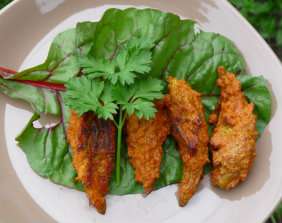 There is not a doubt that milkweed pods are a seasonal treat and I must stress that collecting these should be done sparingly. Various species of butterflies are slowly becoming endangered and butterflies love the milkweed plant. However, the good news is that depending on location, the milkweed plant grows prolifically.
There is not a doubt that milkweed pods are a seasonal treat and I must stress that collecting these should be done sparingly. Various species of butterflies are slowly becoming endangered and butterflies love the milkweed plant. However, the good news is that depending on location, the milkweed plant grows prolifically.
When collecting milkweed pods for consumption they should not be any longer than 6 cm in length. Any longer than that then the seeds are starting to form making these not so palatable. Before becoming seeds, the small milkweed pods contain what is called milkweed silk, or floss. This tastes lightly sweet with no overpowering flavour and it simply tastes delicious.
Milkweed pods provide us with some nutrition including fibre. There is also some vitamin E, carotenoids, sterols, and unsaturated free fatty acids (especially omage-7 once the seeds have developed. In fact, there is a company in Nebraska that extracts this oil for a balm that they claim helps as an anti-inflammatory.
This plant has some interesting history. The hollow fibers are coated in a slightly waxy film which makes them buoyant and waterproof. During World War II the Japanese occupied Java and this cut off US supplies of kapok, a fluffy plant fiber used in aviators’ suits and life jackets. US defense contractor War Hemp Industries enlisted school children to harvest ripe milkweed pods, paying them 15 cents to fill an onion bag with pods (click here to see an old newspaper advertisement for milkweed pickers). Each open-mesh bag held about 600 to 800 pods. Two bags provided enough floss to make one life vest. More than 1.5 billion pods were collected to make 1.2 million life vests.
Milkweed floss is also used for stuffing jackets, comforters, and pillows. It apparently has an insulating effect that surpasses goose down.
One thing is for sure, there is no shortage of recipes out there for milkweed pods, but this one is the best for those who love buffalo style chicken wings; Buffalo Style Milkweed Pods is the vegetarians answer to this favourite meal. To find out how to make this amazing meal click here! (To learn how to identify milkweed click here.)
Sources:
The Washington Post: http://www.washingtonpost.com/wp-srv/special/metro/urban-jungle/pages/120925.html
Characterization of potential health promoting lipids in the co-products of de-flossed milkweed: Schlegel et al. University of Nebraska 2011.




Thank you for this awesome post!! I can’t wait to try the recipes! I gave a shout out on my blog, here is the post: http://earthseeddetroit.blogspot.com/2014/10/the-herbal-confessional-herbal-update-3.html
Thanks for the shout out! Much appreciated Lottie!! 🙂
nice article